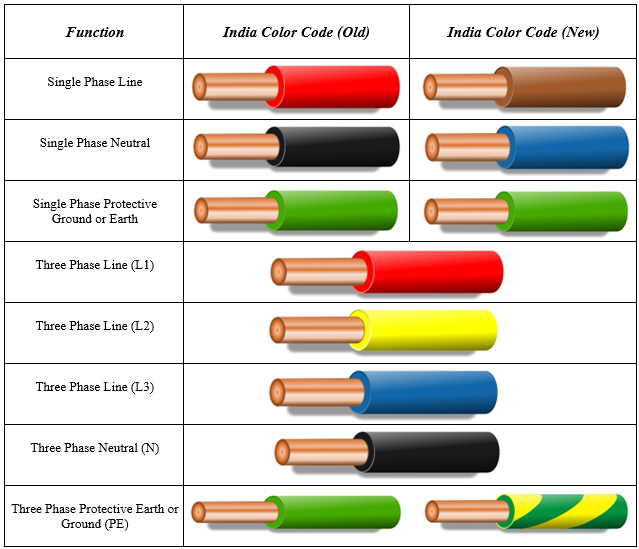Decoding Wire Colors: What Green, White, Red, and Black Wires Mean
Ever wondered what the different colored wires snaking through your walls actually mean? Understanding the significance of wire colors, especially green, white, red, and black, is not just for electricians – it's vital knowledge for anyone undertaking DIY projects or simply wanting to understand the electrical systems in their home. This seemingly small detail can be the difference between a successful installation and a dangerous mistake.
Wire color codes provide a universal language for electricians, simplifying complex wiring systems and ensuring safety. While variations exist depending on the specific application and local regulations, the common understanding of green, white, red, and black wires forms the foundation of electrical wiring in many regions. Misinterpreting these colors can lead to short circuits, appliance malfunctions, or even electrical shocks. This guide aims to demystify the meaning of these common wire colors, equipping you with the knowledge to navigate electrical projects with confidence.
Let’s break down the meaning of each color: Green typically signifies a ground wire, offering a path for excess electricity to flow safely to the earth, preventing shocks. White usually represents the neutral wire, completing the electrical circuit and providing a return path for the current. Red and black wires often indicate hot wires, carrying the electrical current to power your devices. However, the specific function of red and black can vary depending on the wiring system, such as in 240-volt circuits or three-way switches.
Understanding these basic color designations is just the starting point. It's crucial to remember that while these color codes are generally consistent, exceptions can exist. Older wiring systems might not adhere to current standards, and some applications, like automotive wiring, use different color schemes altogether. Therefore, always double-check local electrical codes and consult a qualified electrician when dealing with unfamiliar wiring.
The history of wire color coding emerged from the need for standardization and safety in electrical installations. As electrical systems became more complex, a universal system of color identification became essential to prevent misconnections and ensure the safety of both electricians and end-users. This standardized approach has greatly reduced the risk of electrical accidents and simplified the process of troubleshooting electrical issues.
For example, in a standard 120-volt household circuit, the black wire carries the current to the light fixture or outlet, the white wire returns the current, and the green wire provides a grounding path for safety. In a 240-volt circuit, such as for an electric dryer or oven, both red and black wires can be hot, carrying different phases of the electricity.
Three key benefits arise from understanding wire color codes. First, safety: correctly identifying wires prevents accidental shocks and fires. Second, efficiency: color coding streamlines installation and troubleshooting, saving time and effort. Third, compatibility: the standardized system ensures that different electricians can work on the same system without confusion.
Advantages and Disadvantages of Standardized Wire Colors
| Advantages | Disadvantages |
|---|---|
| Enhanced Safety | Potential for Misinterpretation in Older Systems |
| Simplified Troubleshooting | Variations in International Standards |
| Efficient Installation | Colorblindness Challenges for Some Individuals |
Five Best Practices for Working with Wires:
1. Always turn off the power at the breaker before working on any electrical wiring.
2. Use a voltage tester to double-check that the power is off before handling wires.
3. Consult local electrical codes for specific regulations and requirements.
4. If you are unsure about any aspect of the wiring, consult a qualified electrician.
5. Use wire connectors and appropriate insulation to ensure secure and safe connections.
Frequently Asked Questions:
1. What does a green wire mean? Generally, it indicates a ground wire.
2. What does a white wire mean? It typically signifies a neutral wire.
3. What do red and black wires mean? They usually represent hot wires.
4. Can wire colors vary? Yes, they can vary based on application and local codes.
5. Why is understanding wire color important? For safety and proper electrical function.
6. What should I do if I encounter unfamiliar wiring? Consult a qualified electrician.
7. Are there different color codes for different countries? Yes, variations exist internationally.
8. Where can I find more information about local electrical codes? Contact your local building authority.
Tips and Tricks: When working with wires, always label them clearly if you disconnect them to avoid confusion during reassembly. Take clear photographs of existing wiring before making changes for reference.
In conclusion, understanding what green, white, red, and black wires signify is paramount for safe and effective electrical work. While this guide offers a basic understanding of common wire color codes, it is crucial to remember that variations can exist. Always prioritize safety by double-checking local regulations and consulting a qualified electrician when needed. The benefits of correctly identifying wires extend beyond simple functionality; it safeguards against potential hazards and ensures the long-term reliability of your electrical systems. By taking the time to learn these color codes, you empower yourself to make informed decisions and tackle electrical projects with confidence, ensuring the safety and proper functioning of your home or workspace. Don’t underestimate the importance of this seemingly small detail – it can make all the difference. Take the time to learn, and always prioritize safety.
Elevating celebrations the art of pink cake toppers
Unlock your bowling potential top hybrid reactive bowling balls
Space saving sensations your ultimate guide to small shower room ideas and plans
/ElectricalWiring_FINAL2-5c01dc0546e0fb0001f4d760.png)








:max_bytes(150000):strip_icc()/SPR_1152863-electrical-wire-color-coding-5afca004fa6bcc0036b72fd5.png)


:max_bytes(150000):strip_icc()/color-coding-of-electric-wires-1152300-FINAL-5bbcc3f846e0fb00265e6788.png)

